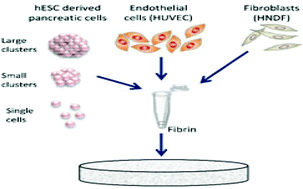The effect of endothelial cells on hESC-derived pancreatic progenitors in a 3D environment†
Abstract
Generating transplantable β-like-cells from human embryonic stem cells (hESC) could serve as an ideal cell-based therapy for treatment of type 1 diabetes, which is characterized by the destruction of insulin-secreting pancreatic β-cells. There are several protocols for differentiating hESCs into pancreatic or endocrine precursors. However, so far, production of mature, functional β-like-cells has been achieved mainly by transplanting hESC derived pancreatic progenitors (PPs) and allowing several months for maturation to occur in vivo. One approach, believed to have potential in promoting differentiation into β-like-cells prior to transplantation, is culturing PPs alongside blood vessels. Endothelium and blood vessels have been shown to direct pancreatic development during embryogenesis and also induce endocrine differentiation in vitro. Here we designed a three-dimensional (3D) construct utilizing highly porous polymeric scaffolds that mimic natural conditions and provide cells with mechanical support, and used it in the differentiation protocol. Clusters of hESC derived pancreatic precursor cells were embedded within the scaffolds along with human endothelial cells (ECs) and fibroblasts forming vessel-like networks. Culturing these clusters with ECs for one week significantly increased the population of PPs, characterized by co-expression of the pancreatic markers Pdx1 and Nkx6.1 and also highly induced Ngn3 expression which indicates commitment to endocrine fate. The presence of fibroblasts, however, reduced this cell population. Three months upon implantation of constructs containing clusters and ECs or clusters alone, implanted mice retained normal blood glucose levels after treatment with STZ, while un-implanted mice became diabetic. These findings may lay the foundation for creating an optimal tissue-construct that will support PPs’ maturation in vitro and enhance graft function upon implantation.


 Please wait while we load your content...
Please wait while we load your content...